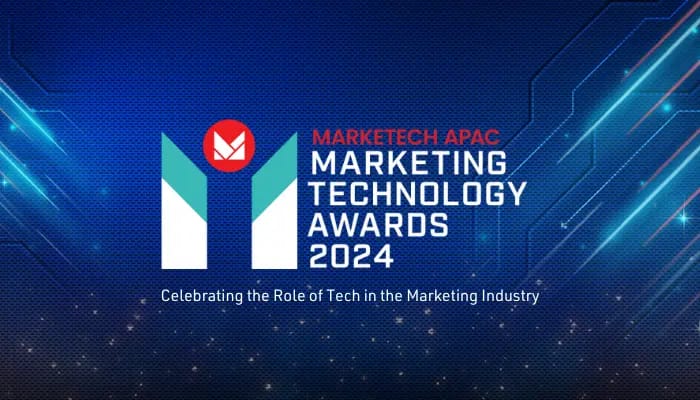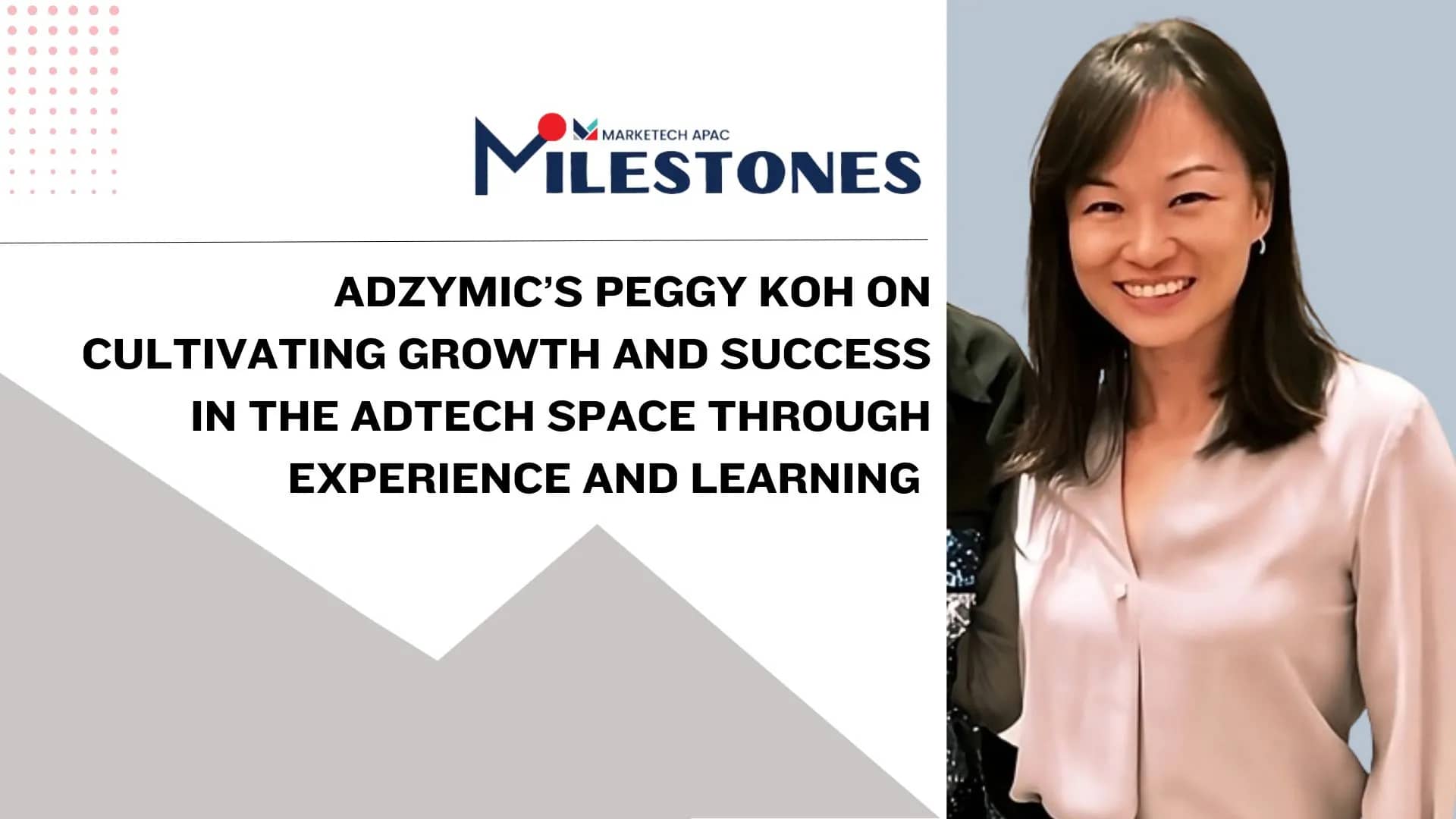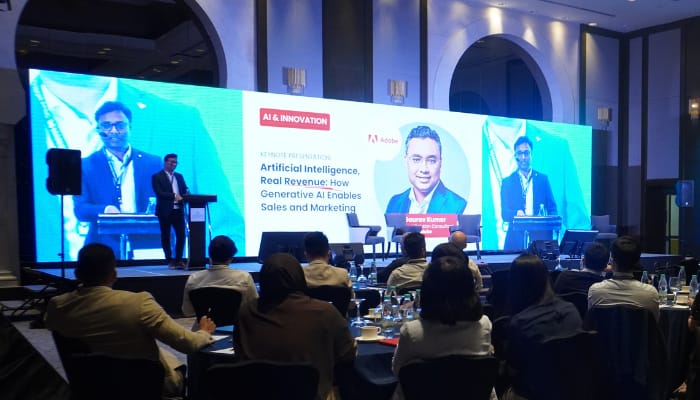The leadership journey is often marked by resilience, determination, and the relentless pursuit of excellence. It takes unwavering dedication and profound commitment for someone to rise and achieve success, not only for themselves but also for the organisation they serve.
For MARKETECH APAC’s third Milestone Series article, we spoke with Peggy Koh, vice president of growth partnerships for SEA and Greater China at Adzymic, to share one of her greatest milestones — rising to her current position today to sharpen the company’s focus on SEA as its key region driving growth.
In this narrative, Koh shares her journey and experiences throughout her career, her leadership work, and her insights on driving growth for a small tech company.
Climbing higher and pushing forward
Before joining Adzymic, Koh handled several marketing and sales roles in other companies. Most notably, she served most of her career in the banking industry, having worked both in local and regional management roles at DBS Bank, Citi, and UOB.
Bringing with her everything she’s learned in her previous roles, she joined the creative dynamic management platform Adzymic in 2021, where she took on the role of head of growth and client success. Her responsibilities then include managing the company’s key global accounts, ensuring that they deliver successful campaigns, and driving further growth for its clients and the company.
It didn’t take long for Koh to earn herself a promotion, welcoming 2024 as the VP of partnerships for SEA and Greater China.
Her extensive background, having been both a media owner and a client, and her holistic understanding of the Southeast Asian market, where she had worked for so long, paved the way for her to develop strategies that were instrumental in positioning Adzymic in the key region.
Koh shared, “Every step in my career has led me to today. I cut my teeth doing online media sales for a small firm back in the early 2000s, when digital media was the complete underdog, and picked up the basics. Thereafter, a 12-year marketing career in the banking industry, managing both local and regional roles, was instrumental in letting me gain experience in the corporate world, understanding how decisions are made on the client side and also observing how corporate culture is built in global organisations.”
Leading Adzymic towards success
As the vice president of partnerships for SEA and Greater China, Koh oversees both sales and marketing roles. For her, both roles ‘naturally feed off one another’, which is why it’s important to ensure synergy between these two functions.
“In sales, whenever we clinch projects with notable brands, the marketing kicks in to craft case studies that tell our DCO (Dynamic Creative Optimisation) stories to foster more learning in the industry of our adtech application. We make it a point to be present at major martech events in all markets we are active in, to stamp our presence, and to showcase our client brand portfolio. This in turn increases our visibility to become a well-established DCO brand that’s born and bred in Asia, with keen Asian insights and understanding of how local business is done,” she stated.
Koh believes that her exposure to new markets has propelled the growth and development of her business acumen, negotiation skills, and understanding of different cultures. After only working in the Singapore market, she is now managing networks in six markets for Adzymic.
With this, from having two team members, she now handles a team of ten across SEA and Hong Kong for both sales and key account servicing. Her understanding of the role and the market is relevant in leading her teams to work towards achieving their objectives.
However, as they are still a relatively small tech company, Koh also knew that one of the challenges of being a leader is attracting and retaining talent. In a competitive market such as Southeast Asia, many talents would flock to bigger companies with more established names in the industry.
This is why Koh shared that she also felt grateful and fortunate to have found goal-driven and talented young people who are rendering their time and skills to support Adzymic’s goals across all of its key markets.
“I see it as my job to build up the Adzymic culture, one that is nurturing of our people’s talent and career skill sets, and I’d like our people to have a strong sense of belonging here as we truly value everyone’s hard work and contributions,” she added.
Staying ahead of the curve
Navigating the dynamic and competitive tech landscape is no easy feat for many who have tried to penetrate its intricate web of opportunities and challenges.
The global adtech market, in particular, is showing promising numbers, with an estimated growth of USD 1.4 billion by 2030. And the Asia-Pacific region is among the fastest-growing in this area, according to a report by MarketsandMarkets.
And Koh is confident that Adzymic is already well-positioned to capitalise on this projected growth rate.
She shared that the company is always looking for ways to stay at the forefront of the curve, making sure to offer solutions that answer the evolving needs of their clients, such as new ways to apply DCO techniques by harnessing data and focusing on mobile advertising formats. The company also recently launched its APX to bring high-impact skinners and mobile scrollers to Asian advertisers.
Furthermore, the company’s campaigns were able to successfully showcase Adzymic’s well-differentiated propositions for their Asian clients. Among their works, two that stood out the most are their campaigns for Income Insurance Singapore and Standard Chartered Hong Kong.
For Income Insurance Singapore, a client with advanced martech stacks, Adzymic DCO developed as many ad variants as their data insights could generate to consistently support higher performance with relevant messaging.
Meanwhile, for a client that embraces innovation and fresh approaches to advertising, such as Standard Chartered Hong Kong, Adzymic activated new and innovative rich media formats to meet their campaign objectives.
Furthermore, Adzymic currently boasts a strong brand portfolio and a client base. And so, one of Koh’s main jobs is to maintain and strengthen these relationships to ensure customer satisfaction and loyalty.
She noted how Adzymic places great importance on their customer service, making it the centre of their organisation and their very DNA. For them, it’s important to employ a customer-oriented mindset, making sure they are doing their best for every client.
“Our adtech solution is dynamic, our tech team is innovative and imaginative, and our account managers are trained up to be conscientious and strong at managing projects and timelines. When you do something well, the results and the experience speak for themselves; trust is built, and then clients will naturally stay with you over the long run,” she continued.
Reflections approaching her third anniversary
When asked what moment in her career is the most rewarding, Koh says it’s her time now in Adzymic as she was able to make the most impact in her workplace.
“It will be 3 years in a few weeks’ time. With Adzymic, it’s always felt intuitive, with a sense of constant growth and positive learning, and I’m really coming into my own at this juncture. It’s not a glamorous large corporate organisation, but it’s a place where I feel safe to learn, grow, and be empowered to contribute,” she said.
With an excited outlook on what lies ahead in her future, Koh simply ends with, “I’m excited to see where this path will take me! ”
This piece is published under MARKETECH APAC’s content series ‘Milestones’, which celebrates the different milestones and achievements of industry leaders across the Asia-Pacific region. Please reach out to [email protected] for more information.












